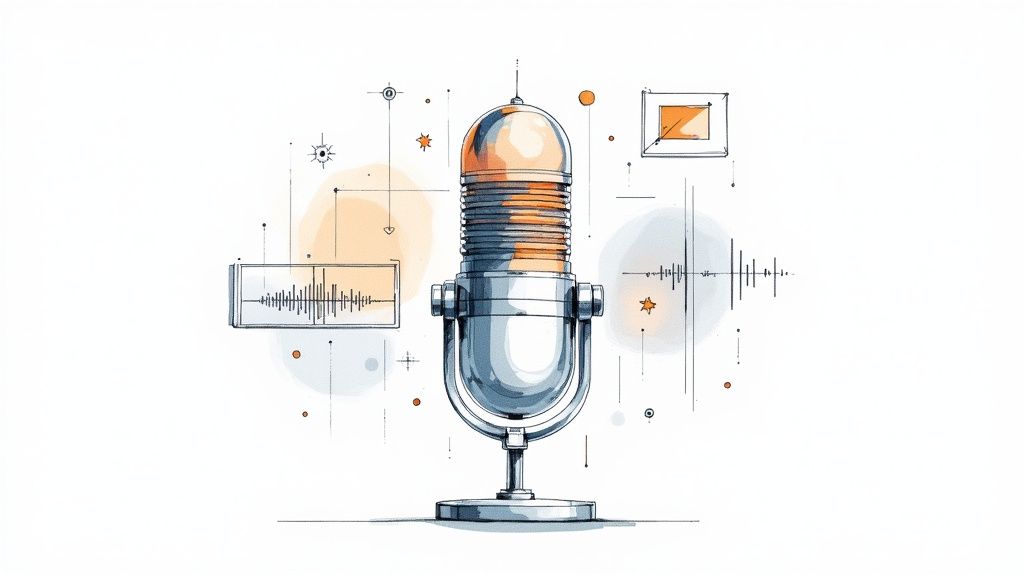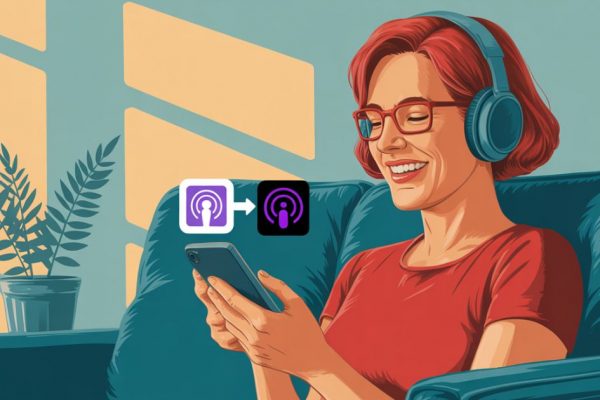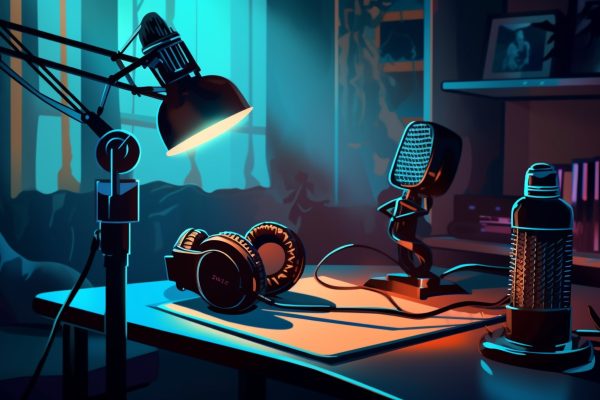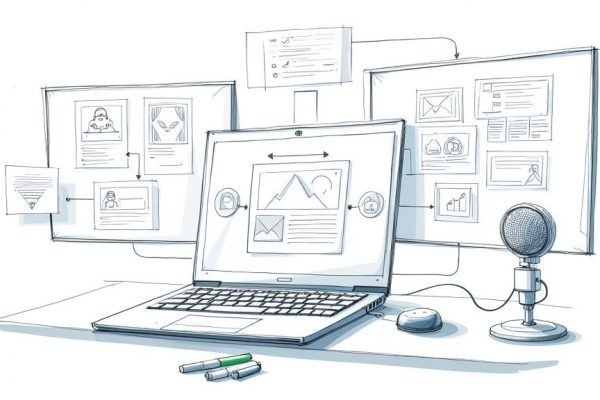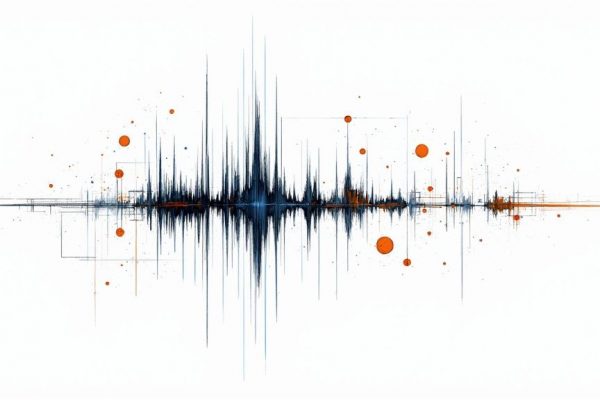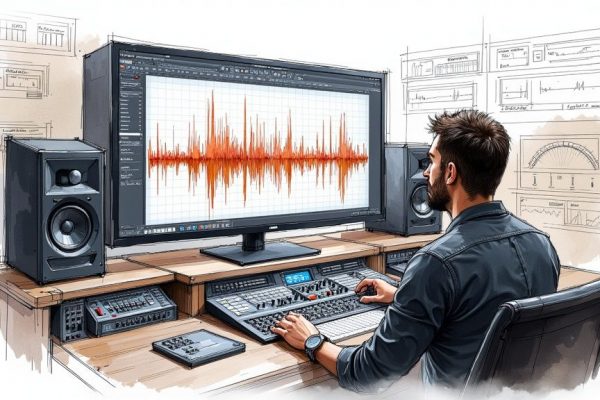Introduction to Video Podcasting

Descubre aquí cómo crear un podcast en 2025
The world of audio is constantly evolving, and the videopodcast presents itself as one of the most interesting trends. It combines the ease of listening to traditional podcasts with the dynamism of video, creating a much more complete experience for the audience. Additionally, it can be consumed on YouTube, a platform that today gives us much more reach than podcasting platforms.
Next, we will explore what a videopodcast is exactly, its importance in the current context, and how it is changing the way many consume podcasts.
What is a Videopodcast?
Essentially, a videopodcast is a podcast with the incorporation of video. It’s like having a window into the recording of your favorite podcast, where you can see the presenters, their gestures, and reactions. This not only adds an extra layer of interest but also allows for a deeper connection with the audience. For example, in a cooking podcast, instead of just listening to the recipe, you can see the chef preparing it step by step. This visual difference makes the content more attractive and easier to follow.
This format is gaining a lot of popularity, especially among new generations who seek more interactive experiences. Various studies show that the inclusion of video in podcasting is crucial for creating online communities, which has led to the development of specialized platforms offering specific tools for its production and dissemination.
The Rise of Videopodcasting
Videopodcasting is not just a passing fad but a response to the growing demand for video content. Platforms like Spotify Spain have registered a significant increase in the production and consumption of videopodcasts in recent years. Additionally, integration with platforms like YouTube and other social media has further boosted their visibility. Being able to see the presenters’ reactions, along with the inclusion of graphics and other visual elements, enriches the experience and makes it more appealing.
This growing popularity is also due to the increasing accessibility of video creation and editing tools. Many creators, for example, use their own smartphones to record, demonstrating that expensive equipment is not needed to start. Finally, the versatility of the format allows the audience to enjoy it in various ways: watching the full video or simply listening to the audio while engaging in other activities. This flexibility is key to reaching a broader audience and adapting to different lifestyles.
Essential Equipment to Get Started
El mundo del audio está en constante evolución, y el videopodcast se presenta como una de las tendencias más interesantes. Combina la facilidad de escucha de los podcasts tradicionales con el dinamismo del video, creando una experiencia mucho más completa para la audiencia. Además se puede consumir en Youtube, una plataforma que hoy en día nos da mucho más alcance que las plataformas de podcasting.
Practical Aspects of Creating a Videopodcast

Once we understand what a videopodcast is and why it’s trending, it’s crucial to discuss the practical aspects of its creation. A high-quality videopodcast requires an appropriate equipment setup, which is essential for ensuring a good experience for both creators and listeners. This setup is also the main challenge when producing a videopodcast.
Next, we’ll review the basic equipment needed to start producing your own videopodcast. Just as a good filmmaker needs the right tools, a videopodcaster also needs the correct equipment to share their message.
The Essential Trio: Audio, Video, and Lighting
The success of a videopodcast largely depends on the quality of the audio, video, and lighting. We’ve become accustomed to a minimum level of quality, and if we don’t find it in a video, we’ll leave within the first three seconds. These three elements work together to create an attractive audiovisual experience. Imagine a videopodcast with poor audio or a dark, pixelated image: the audience will quickly lose interest. Therefore, investing in basic equipment that guarantees a minimum level of quality is fundamental. It doesn’t have to be expensive, but it must be functional. Let’s start with audio.
Microphone: The Voice of Your Videopodcast
A good microphone is the foundation of any good videopodcast. Audio clarity is crucial for the audience to understand and enjoy the content. A low-quality microphone can ruin the experience, even if the video is excellent.
There are different types of microphones, from basic ones that connect to a computer to professional ones. Initially, a good-quality USB microphone will suffice. As your videopodcast grows, you might consider investing in more advanced microphones. For example, a dynamic microphone is ideal for recording in noisy places, while a condenser microphone is more sensitive and captures voice nuances better.
Camera: Capturing the Visual Essence
The camera is the eye of your videopodcast. Although you don’t need a professional camera to start, it’s important that the image is clear and well-lit. You can use a good-quality webcam or even your smartphone’s camera.
However, a dedicated video camera will give you more control over image quality, resolution, and other settings. This allows you to create a visually more appealing videopodcast. You can experiment with different angles and shots to add dynamism to the image. Consider how YouTubers use various shots to keep their audience engaged.
Lighting: Bringing Your Content to Light
Lighting is the third key element for a high-quality videopodcast. Good lighting not only improves the image but also creates a more professional atmosphere. You don’t need a recording studio, but you should ensure the lighting is adequate and uniform. You can use natural light by positioning yourself near a window or artificial light, such as desk lamps or ring lights.
A ring light, for example, is a popular tool among videopodcasters because it provides soft, uniform lighting, eliminating facial shadows. Remember, good lighting can make the difference between an amateur and a professional videopodcast. This often-underestimated aspect has a significant impact on the final result.
Additional Software and Hardware
In addition to the essential trio of audio, video, and lighting, there are other elements that can enhance the quality of your videopodcast. Good recording and editing software is crucial for polishing the audio and video, adding effects, transitions, and music.
You’ll also need a computer with sufficient capacity to process video. A tripod for the camera, headphones to monitor audio, and an attractive background for the video are other elements to consider for a more professional result. These additional elements, although not essential to start, will help you create a more polished and professional videopodcast, attracting and retaining a wider audience.
Content Planning Strategies for Your Videopodcast
Once the equipment is ready, the next fundamental step for a successful videopodcast is content planning. Just as an architect needs a plan before building a house, a videopodcaster needs a solid plan to structure their content and keep the audience engaged. A well-defined strategy will allow you to create coherent, attractive, and optimized episodes to attract new listeners and retain existing ones. This planning will also help you optimize your videopodcast for search engines, making it easier to discover on platforms like Spotify and YouTube.
Define Your Niche and Target Audience
Before recording, you must define your videopodcast’s niche and target audience.
- What will you talk about? Video games, cooking, digital marketing, or another topic? Once you have your niche clear, think about your ideal audience.
- What interests them?
- What do they need?
- What do they prefer?
Knowing your audience will allow you to create relevant content. For example, if your videopodcast is about video games and your audience are novice players, your content should be educational and easy to understand, avoiding complex strategies for experienced players. Defining your niche and audience is like choosing the destination of a trip: without a clear destination, you’ll get lost.
Create an Editorial Calendar
An editorial calendar is essential for maintaining consistency. It will help you organize your ideas, schedule recordings, and publish regularly. You can use a spreadsheet, an online calendar, or any tool that works for you. Include the topic of each episode, the recording date, the publication date, and any other relevant information, such as guests or resources. Just as a gardener plans what to plant in each season, a videopodcaster must plan their content to maintain audience interest. This calendar will serve as a guide and prevent a lack of ideas.
Structure Your Episodes
Each episode should have a clear structure in the form of a script or outline. This will help keep the audience engaged and facilitate understanding of the content. A common structure includes an introduction, development of the main topic, and a conclusion. Within the development, you can use different segments: interviews, debates, examples, analysis. Think of each episode as a mini-movie, with a beginning, development, and end. A well-structured videopodcast uses segments to organize information and make it more digestible for the audience, like the chapters of a book.
Research and Document
Research is fundamental for creating quality content. Thoroughly research each topic to offer precise and relevant information. Use reliable sources and verify the information before including it in your videopodcast. Also, stay updated on the latest trends in your niche. A videopodcaster must research to offer valuable content to their audience, just like a journalist investigates before writing an article. This will help keep your videopodcast fresh and relevant.
Interact with Your Audience
Finally, interact with your audience. Encourage listeners to leave comments, questions, and suggestions. Respond to their comments and participate in conversations. This will help you create a community and obtain valuable feedback to improve. A videopodcast is not a one-way communication; it’s a conversation. By interacting, you show that you care about their opinion. This not only strengthens your community but also gives you ideas for future episodes.
Best Practices for Recording

With your equipment ready and content planned, it’s time to record. However, having a good microphone and camera does not guarantee a professional result. Just as a musician needs more than instruments to create good music, a videopodcaster needs to master certain recording techniques. We will explore the best practices for obtaining a high-quality recording that captivates your audience. These tips will help you refine your videopodcast and make it stand out on platforms like Spotify or YouTube.
Audio: The Key to an Immersive Experience
Audio quality is essential in a videopodcast. Many consider it even more important than video quality. Clear audio allows the audience to focus on the message. To achieve this, consider these points:
- Sound Test: Before recording, do a test to adjust the microphone levels and eliminate background noise. This will save you time and frustration.
- Acoustic Material: Use acoustic foam or, if not available, materials that absorb sound (curtains, wood, clothing, carpets…).
- Quiet Environment: Record in a quiet place without sound distractions. Turn off the air conditioner, close windows, and eliminate any noise that could interfere.
- Monitoring: Use headphones to monitor the audio in real-time and detect any sound problems to correct them instantly.
- Microphone Position: Place the microphone at an appropriate distance from your mouth, generally between 15 and 20 centimeters. Experiment to find the optimal point.
Video: Creating a Visual Connection
Video adds a visual dimension that makes your videopodcast more attractive. Just as a good TV presenter uses body language, you can use video to connect with your listeners. Here are some tips:
- Consistent Lighting: Maintain consistent lighting throughout the recording. Avoid sudden changes in light.
- Framing: Frame the shot so that you look good on screen. Proper framing creates a more professional image.
- Background: Choose a clean and organized background that does not distract the audience.
- Eye Contact: Look directly at the camera as if you were talking to your audience. If you are interviewing someone, maintain eye contact.
Recording a Videopodcast with Multiple Participants
If your videopodcast includes several participants, coordination is key. Ensure everyone has good audio and video. If they are recording from different locations, use software that allows you to record audio and video separately. You must coordinate the participants, like a conductor, to create a smooth experience. Planning and communicating before recording is essential for a successful videopodcast. This preparation will allow for a problem-free recording and a high-quality final result.
Post-Production
After recording, comes post-production. This step is crucial for transforming your recordings into a polished and professional product. It’s like the work of a sculptor refining their piece. A good post-production workflow will allow you to optimize your videopodcast for platforms like Spotify Spain and YouTube.
Audio Editing: Refining the Sound
The first step is audio editing. Even if you recorded in a controlled environment, there might be background noise. Clean audio is essential for your videopodcast to be easy to listen to. Use editing software to remove noise, adjust volume, and equalize the audio to make it sound professional. For example, you can remove air conditioner noise with noise reduction tools. You can also improve quality by adding effects like compressors and limiters.
Video Editing: Creating a Visual Narrative
After audio, comes video editing. This is where all visual elements come together. You can cut unnecessary parts, add transitions, graphics, text, and other elements to make your videopodcast more dynamic. It’s like assembling a puzzle: video editing is where you fit all the pieces together. You can also correct lighting or framing issues.
Integrating Audio and Video: The Perfect Union
Once audio and video are edited separately, you need to integrate them correctly. Ensure the audio is synchronized with the video and there are no delays. Unsynchronized audio can be very annoying. This step is like tuning a musical instrument: all parts must be in harmony. Once synchronized, your videopodcast is ready to be exported.
Export and Optimization: Preparing Your Videopodcast for the World
The final step is export and optimization. Choose a video format compatible with the platforms where you will publish it. Optimize the settings to ensure good quality without making the file too heavy. It’s like packaging a gift: it must be attractive and practical. Once exported, it will be ready to be shared.
Distribution
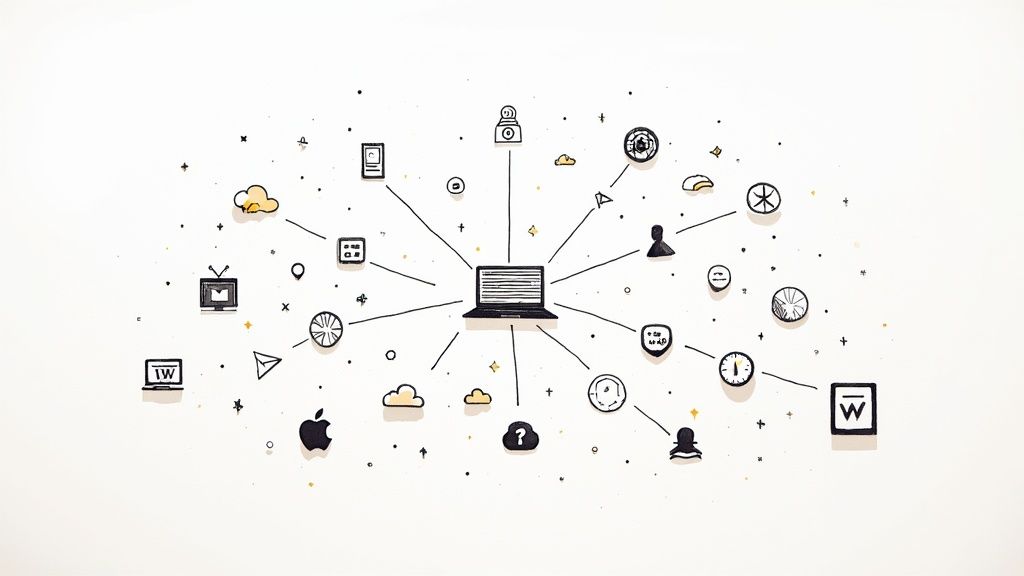
The first step is to choose the right platforms. You should select platforms where your target audience is located. Some of the most popular ones include:
- YouTube: Ideal for hosting your videopodcast due to its wide reach. You can use its optimization tools to improve visibility.
- Mumbler: Perfect for hosting your podcast. The content and subscribers are yours, unlike YouTube or Spotify. Discover all the features of Mumbler.
- Spotify: A leading platform for distributing audio and video, allowing you to reach an audience interested in podcasts.
- Apple Podcasts: Allows you to reach users of Apple devices.
- Google Podcasts: Gives you the opportunity to reach Android users through Google’s search engine.
- Your own website: Gives you total control over the user experience.
Mumbler: The Platform for Your Podcast
If you’re looking for a comprehensive solution to host, distribute, and promote your videopodcast, Mumbler is an integral platform designed for content creators. It offers advanced metrics, uninterrupted audio insertion, AI transcription, and monetization options. Additionally, as a Spotify partner, Mumbler allows you to publish and sell your audio products on Spotify effortlessly. Discover Mumbler today and start building your videopodcast empire.
About the author
Mumbler CEO & Cofounder. Slow content creator: newsletters, podcasts and videos.
